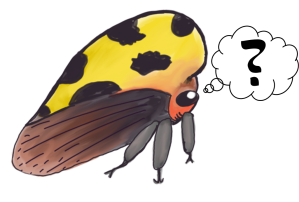At about this time of year I expect to start getting a lot of questions about the Brown Marmorated Stink Bug, or the BMSB as I like to call it. It’s an introduced stink bug from Asia, which has quickly spread across the US and has become a pest of agriculture, gardens and households. Because they’re not native, they don’t have a whole lot of predators and parasitoids which keep them in check in their native environment.
Much like the Multicolored Asian ladybeetle, these guys look for places to overwinter. Much like the Multicolored Asian ladybeetle, these guys also like to hibernate in houses. As a result, they get everywhere in huge numbers. So there’s a lot of people who go out and spray for them around their houses.
I’ve seen some discussions online, mainly through Facebook groups I’m a part of, about spraying for stink bugs in the garden. Unfortunately, it’s not uncommon to see pictures of predatory stink bugs posted while discussing the invasives. To be fair, the more common predator Podisus does actually look very similar to the BMSB. So the mistake is understandable, but spraying these guys would remove some of the predators from the garden which would keep the pest population down.
So I thought it would be a good idea to get some resources out there for gardeners to help ID their stink bugs.
First, here’s a comparison of the predatory Spined Soldier bug and the BMSB. The feature I use, the proboscis, is on the underside of the insect. All predatory stink bugs have a thick proboscis they use to kill their prey, a lot like assassin bugs. So it’s a really good clue to quickly know if you’re looking at a good stink bug, or a bad one.
However, a lot of people might not be comfortable picking them up. That’s OK…Entomophobia is definitely something I understand. In that case, you can also use the spines and colors to tell these insects apart. The predatory stink bugs have sharp spines, whereas BMSB has dull spines. The BMSB also has white bands on their antennae, which are absent from the predatory ones.
This is mostly meant as a two-second field guide for telling apart the most common predator from the most common pest. Stink bugs are a really diverse group, and this isn’t meant to help you tell them all apart. Thankfully, Virginia Tech has a really nice and accessible key which gardeners can use to tell these guys apart.
Correction 8/31/15 10:00 PM: An earlier version of this image featured a misidentified Euschistus sp. as a Podisus.



That stink bug on the top left is actually phytophagus. Probably Euschistus tristigmus tristigmus. The best way to differentiate Podisus is the black streak on the clear membrane where their wings come together like you can see here or in Mike’s ventral shot:
http://bugguide.net/node/view/1070410/bgimage
LikeLiked by 1 person
Andrew: Thanks for the correction. I had originally wanted to use Quinn’s dorsal and ventral shot side-by-side, but decided at the last second that another color would be more visually appealing. I really should have looked closer at the picture I chose…but the original is above.
LikeLike
Any time, good stuff!
LikeLike
And what do the bad ones feed on. They are in our garden so I know they eat beans but I find them in the garage also. What should we spray them with?
LikeLike
Linda: Stink bugs have a pretty wide diet breadth. They can be pests of soybean, cotton, tomatoes, peaches, apples…just lots of important plants. A lot of their damage is from feeding on the stuff that gets sold.
As for spraying, most of the stuff in your local garden store (usually pyrethrin, or something similar) should work…although you might be able to get away with spot-picking if numbers are low.
LikeLike
Pingback: The mystery of the old stable: Why are there flies all over the place? | Ask an Entomologist
This is great! I have been trying to figure out if I should squish or not. I do turn them over and look, but I did not realize the bad guys had a proboscis too! So, can I look for the spots on the good one on the underside? This might be easier for me to see. I think I have been letting the bad guys go as my motto is, ¨unsure, let it live¨.
LikeLike
Oh bother, I grew up working my Dad’s 40 acre farm plus what ever he rented and stink bugs were always around. I don’t like their looks and the name either so we three just flicked them away from us when ever we saw them. I have never seen them eating the produce or grane we grew and no one ever got bitten. They are just ugly. If they did come here from another country, it must have been started a very long time ago for I am now 66. Besides the Ferrial wild pigs and the chinese beetles, poison hogs wort posing as queen ann’s lace, zebra mussels, Asian Carp, Gypsy moth, green emerald ash, we don’t have much room for any more invasives do we?
LikeLike
Thanks for this helpful post. I have been referring people to it. You can see we had our own encounter with a young soldier bug and almost squashed it for a tick! https://gardeninacity.com/2021/06/19/onward-spined-soldier-bug/
LikeLike